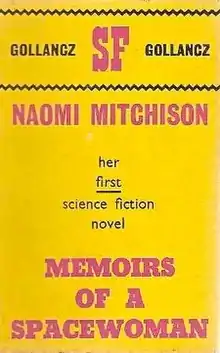Memoirs of a Spacewoman
Memoirs of a Spacewoman is a science fiction novel by Naomi Mitchison, already a noted novelist and poet and sister of the famous biologist J. B. S. Haldane. It was first published in 1962 by Victor Gollancz Ltd.
 Cover of the first edition | |
| Author | Naomi Mitchison |
|---|---|
| Country | Great Britain |
| Language | English |
| Genre | Science fiction |
| Publisher | Victor Gollancz Ltd |
Publication date | 1962 |
| Media type | Print (hardcover and paperback) |
| Pages | 176 pp |
Plot summary
The aforementioned Spacewoman in question is a scientist and explorer. At this point, humans have explored many worlds in a number of different galaxies. Their quest is for knowledge and to be helpful to whom they encounter, but there is a strict rule against 'interference'. It is assumed to be in the far future, but no dates are ever given and it's mentioned that time works differently on different planets. The story is a retelling of the narrator’s experience training and career as a space explorer.
The narrator, Mary, is a specialist in 'communication' - a kind of telepathy that allows her to communicate with nearly every species she comes across in her exploration. She operates in a society where women are just as likely as men to be leaders, though she herself prefers not to lead. She operates in a more utopian society where leadership is not gender-specific, but Mary does make it clear that she does not want to lead herself. Their society is also one that does not engage with the same rules of sexual expression that we do. Mary is aware of her female sexuality and is free to enjoy it as she pleases. This results in her having multiple children. Four of her children are described as “normal” as they were conceived just as any other child. Viola, however, was conceived after her ovaries were stimulated through her interaction with a martian, resulting in a haploid child, who was healthy nonetheless.
Major themes
There are no space-opera thrills and fights: rather there are a number of different worlds with interesting biologies. The expansive worlds that the book explores allow for the discussion of a number of different important ethical issues. One of these discussions focuses on the ethical treatment of animals. The story exemplifies situations where animals were treated as “intellectual equals, or, in certain subjects, superiors”.[1] These actions were taken as an end in themselves, not a method of forming a greater relationship with other humans. This take on sympathy and empathetic treatment towards animals likely stems from Mitchison’s view on the treatment of colonized people of the time.[2] Throughout her life, Mitchinson had seen the formation and independence of a number of different colonies, including India (1947)[3] and South Africa (1961)[4] which both featured very popular independence movements.
Publication history
- 1962, Great Britain, Victor Gollancz Ltd, hardcover
- January 1964, Great Britain, Four Square Books, paperback
- June 1973, United States, Berkley Medallion, ISBN 0-425-02345-1, paperback
- 1976, Great Britain, New English Library, ISBN 0-450-02977-8, hardcover
- April 1977, Great Britain, New English Library Master SF series, ISBN 0-450-03000-8, paperback, with introduction by Hilary Rubinstein
- July 1985, Great Britain, The Women's Press, ISBN 0-7043-3970-6, paperback
- February 2011, Great Britain, Kennedy & Boyd, ISBN 978-1-84921-035-5, paperback
References
- Mitchison, Naomi. Memoirs of a Spacewoman. 1st ed., Victor Gollancz Ltd, 1962 (Page 72)
- Miller, Gavin. “Animals, Empathy, and Care in Naomi Mitchison's Memoirs of a Spacewoman.” Edinburgh Research Explorer, vol. 35, no. 2, 2008.
- Independence Day.” Encyclopædia Britannica, Encyclopædia Britannica, Inc., https://www.britannica.com/topic/Independence-Day-Indian-holiday.
- A Guide to the United States’ History of Recognition, Diplomatic, and Consular Relations, by Country, since 1776: South Africa.” U.S. Department of State, Office of the Historian, https://history.state.gov/countries/south-africa.